07
Feb 2020Chinese Nicknames for the Novel Coronavirus
After sharing the vocabulary about the coronavirus, I got a good question on LinkedIn about a shorter Chinese name for the virus. There are two 4-character names commonly used in Chinese:
- 新冠肺炎 (xīn guān fèiyán) lit. “New corona pneumonia”
- 武汉肺炎 (Wǔhàn fèiyán) lit. “Wuhan pneumonia”
I’m thinking about writing about the name a bit more, since there are so many variations. (Not the most exciting topic, I know, but it’s just so omnipresent these days…)
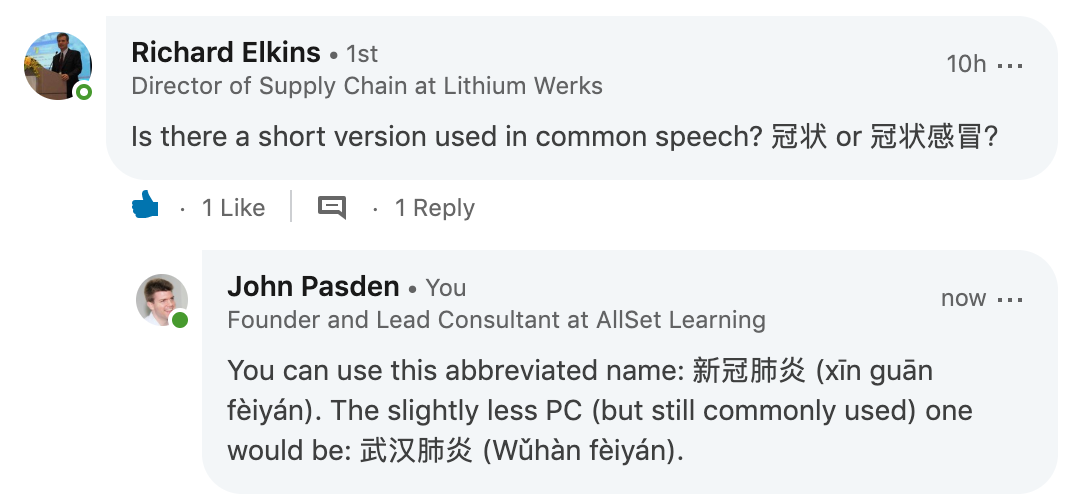

04
Feb 2020The Unavoidable Novel Coronavirus Vocabulary
When I returned with my family from Japan over the past weekend, China had changed. The spread of the coronavirus and the extensive efforts to shut it down had turned Shanghai into a ghost town. The topic absolutely dominates WeChat (and we all live in WeChat over here), whether it’s in one’s “Moments” (feed) or in various WeChat group chats, whether in English or in Chinese.
So my co-workers and I at AllSet Learning got to work creating a series of vocabulary lists to help learners of Chinese deal with this unavoidable topic. The lists are separated by level, so whether you’re only elementary or are already upper intermediate, there’s a list here for you! Do not try to study all the lists (unless you’re already upper intermediate and you’re just filling in little gaps).
Here are the lists in image form (easier to share), but there’s a PDF link at the bottom as well.





Download the COVID-19 Vocabulary PDF on this page.
23
Jan 2020Chinese New Year Quiz Time!
We’ve got lots of new stuff in the works at AllSet Learning, and sometimes it’s even relatively small projects that we can release quickly. The latest of those is our new quizzes. We’ll keep refining the core quiz app, but the first quiz is ready, just in time for Chinese New Year 2020:

Happy Chinese New Year! (Take the quiz, and if you like it, please share!)
16
Jan 2020Shanghai’s Chinese New Year Melancholy
Recently a Shanghainese friend shared this screenshot on WeChat:
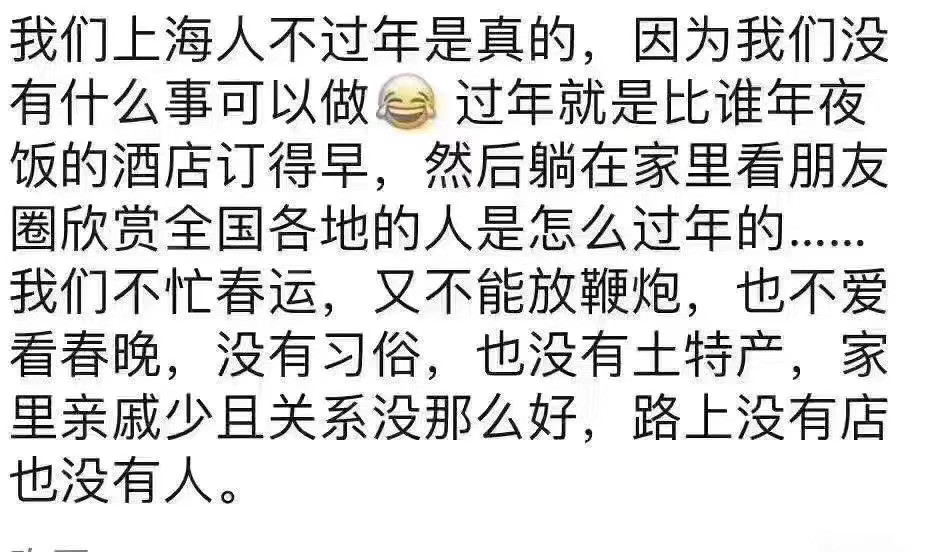
I’ll transcribe it below as text for you learners:
我们上海人不过年是真的,因为我们没有什么事可以做!过年就是比谁年夜饭的酒店订得早,然后躺在家里看朋友圈欣赏全国各地的人是怎么过年的……我们不怕春运,又不能放鞭炮,也不爱看春晚,没有习俗,也没有土特产,家里亲戚少且关系没那么好,路上没有店也没有人。
And a translation:
It’s true that we Shanghainese don’t really celebrate Chinese New Year because there’s not really anything for us to do! Chinese New Year is just competing who can make the earliest restaurant reservation for Chinese New Year’s Eve dinner [年夜饭], then lying around at home browsing WeChat Moments to see how the rest of the country is celebrating Chinese New Year…. We have no fear of the massive CNY migration [春运], and we’re not allowed to set off fireworks anymore. We don’t like the CCTV New Year’s Gala [春晚], and we don’t have any real traditional customs or local specialty foods. We have few relatives, and the ones we do have, we’re not on great terms with. There are no shops open or any people in the streets.
My immediate reaction was, “wow, this is so true! And sad!” I shared it with my co-workers, and a Shanghainese co-worker’s reaction was:
大实话。有时候我会羡慕赶春运的人们。
Translation:
So true. Sometimes I envy those people crammed into trains just to get home for Chinese New Year.
[I had to take liberties translating 春运.]
This year my family and I will spend Chinese New Year in Japan (again). At first I felt uncomfortable with this. You hear Chinese people say all the time, “Christmas is like you guys’ Chinese New Year,” and while that’s not really true in many ways, it is true in that they both are the year’s biggest holiday in their respective cultures, they both mean a lot to the people of that culture, and they’re both meant to be spent with family. But then how could my wife be OK with running off to Japan (without her parents) instead of spending CNY in Shanghai with them? I would not be OK with blowing off Christmas in similar fashion.
One of the ways I’ve made sense of this cultural issue is reflected in the post above: the Shanghainese really do have a bit of a different take on Chinese New Year, and it has evolved rapidly in recent years (as evidenced by the role of WeChat in the original post). The Shanghainese are different.
My first Chinese New Year was spent in Zhuji (诸暨), Zhejiang Province. It was cold, it was crowded, it was noisy, it was non-stop eating and card-playing and tea-drinking chatting. It was undoubtedly very Chinese. It was pretty fun for me, but as an outsider, it’s not something I would really want to commit to every year (especially if it’s not with my actual family).
Over the years, I’ve discovered that I’m not a huge fan of Chinese New Year festivities. But as the traditions have faded in Shanghai and the holiday is left something of a husk of its former self, I can’t help but feel bad for the Shanghainese.
09
Jan 2020Happy New… uhh… Year?
A reader shared this image with me:
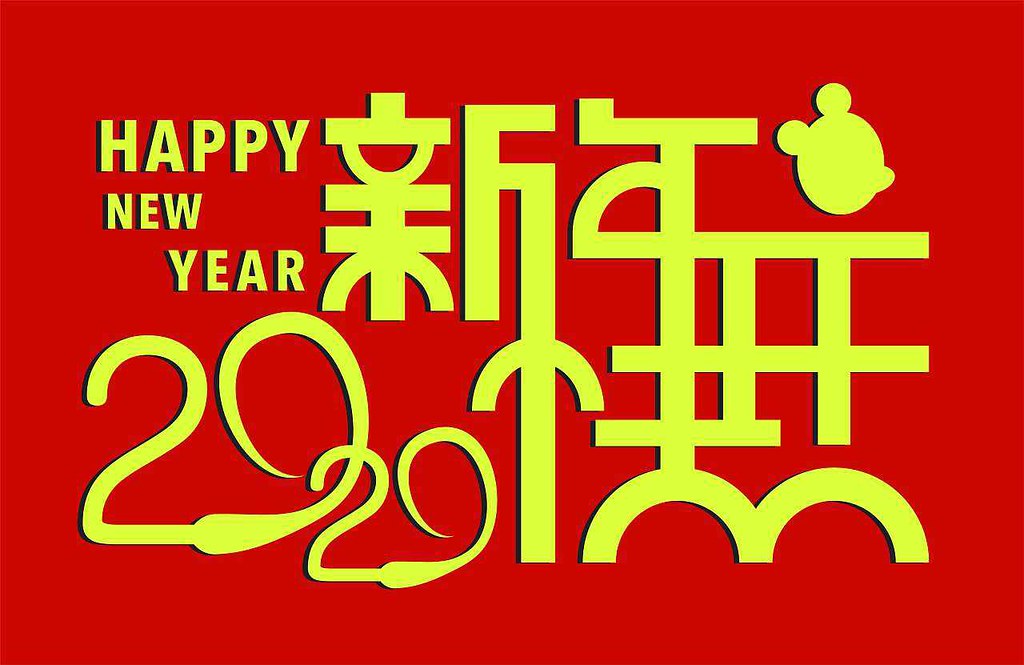
Can you read the Chinese? It’s supposed to say 新年快乐.
I can get the 新年 easily, and then I can make out the 快, but the 乐… the top sort of works, but the bottom just… huh??
It’s fun to see stylizations that don’t work sometimes, too.
P.S. The “translation” I used for the title of this post is sort of a translation of the hard-to-read Chinese. It doesn’t totally work, though, because the “year” part of the Chinese is easy to read; it’s the “happy” part that isn’t. But I didn’t like the sound of “Something New Year,” so here we are! Anyone got a better idea for a translation?
31
Dec 2019New RMB Coins in 2019
I think it really says something that it wasn’t until the last week of 2019 that I even noticed that there are new 1-RMB coins in circulation (I knew about the bills).

What does it say? Well, with mobile payments becoming the new norm in China (at least in big cities), a lot of us just don’t handle much cash anymore (especially coins).
My family just recently visited me in Shanghai, and it was rather surprising for them how “cash-less” meant “mobile payments only,” and foreign credit cards remained largely unusable. The easiest way to get money, by far, was to withdraw RMB in cash from ATMs using American debit cards. (Adding a foreign credit card to AliPay is still early and somewhat unverified.)

What I don’t understand about these RMB coins, though, is the size. Why make them smaller?? It seems like it’s more trouble than it’s worth. I guess it saves on metal, and with fewer and fewer coins actually being used every day, maybe it’s finally the right time…
26
Dec 2019“Baby Yoda” in Chinese
You’re watching The Mandalorian right? It’s the only thing we Star Wars fans have to be happy about in 2019!
Anyway, the breakout hit of the series is no secret: it’s “Baby Yoda” (not his real name).
The Chinese market is famously unimpressed with the entire Star Wars franchise, but just like everyone else, the Chinese love a cute character. So Baby Yoda’s gotta be popular in China too, right? Wellll… kinda. But anyway, we’re talking about how to say “Baby Yoda” in Chinese.
You might be tempted to go straight for the direct translation. Remembering that generic titles (like 老师) typically come come after the “namey” part of the name, you get “Yoda Baby,” or 尤达婴儿. And this name indeed does appear online (currently 216k hits on Baidu).
The Chinese-ier (and cuter) version of the name uses the slangier 宝宝 for “baby,” though, giving us the more natural translation of: 尤达宝宝 (currently 924k hits on Baidu).
So there you have it!

A few other vocabulary tidbits related to the show:
- 星球大战 (Xīngqiú Dàzhàn) Star Wars
- 曼达洛人 (Màndáluò Rén) The Mandalorian
- 原力 (Yuánlì) the Force
- 尤达 (Yóudá) Yoda
- 尤达宝宝 (Yóudá Bǎobao) Baby Yoda
- 曼达洛人 (Màndáluò rén) Mando
- 波巴·费特 (Bōbā Fèitè) Boba Fett
19
Dec 2019Li Ziqi Deserves the Hype
In the past week or so, I’ve suddenly started hearing a lot about the videos of a girl named Li Ziqi (李子柒). She lives out in rural Sichuan and likes to share videos of herself making stuff from scratch (the traditional Chinese way), which includes amazing cooking videos, but also includes creating other stuff as well.
Perhaps what makes her videos most unique (aside from stunning scenery and interesting content) is how little she talks in her videos. I like that. This is the video I watched that totally hooked me, in which she makes an amazing wool cloak from scratch, starting with just the raw wool:
This one on making soy sauce from scratch (and when I say “from scratch” I mean planting the soy beans yourself) was educational:
Li Ziqi is currently getting a lot of attention on Chinese social media. I discovered her myself through a WeChat post. It’ll be interesting to see where public opinion goes. I’ve already heard numerous cries of both “she’d make the perfect wife” and “she’s a fraud.”
Here’s an interview with her:
Anyway, I still need to watch some more videos. But my opinion thus far is that Li Ziqi makes great videos (equally interesting whether or not you’re interested in learning Chinese) and deserves the hype.
12
Dec 2019TA: Pinyin with a Purpose
Mastery of pinyin is important for every beginner learner of Mandarin Chinese. This much is widely agreed upon (although not always thoroughly executed). But what about adult native speakers of Chinese? Aside from using pinyin to type, or maybe occasionally to look up an obscure character which they can guess the reading for, there’s not much use for pinyin in their literate lives, right?
Well, you’re mostly right. Pinyin is mostly supplanted by characters among the literate Chinese population. But there is one small exception: TA.
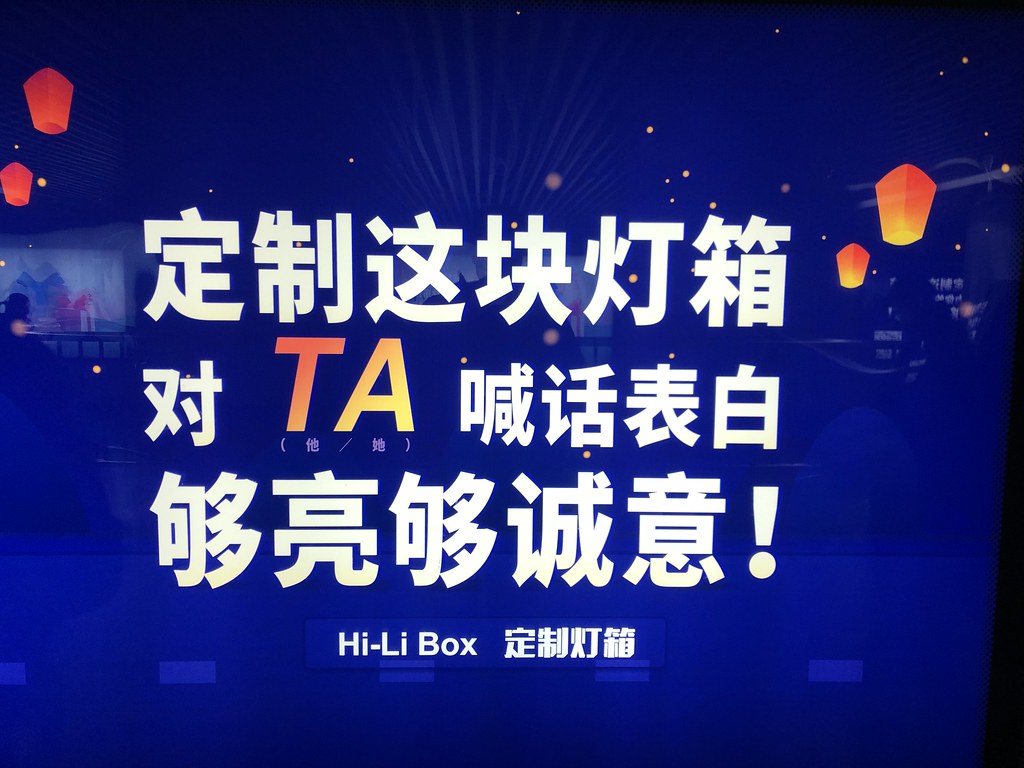
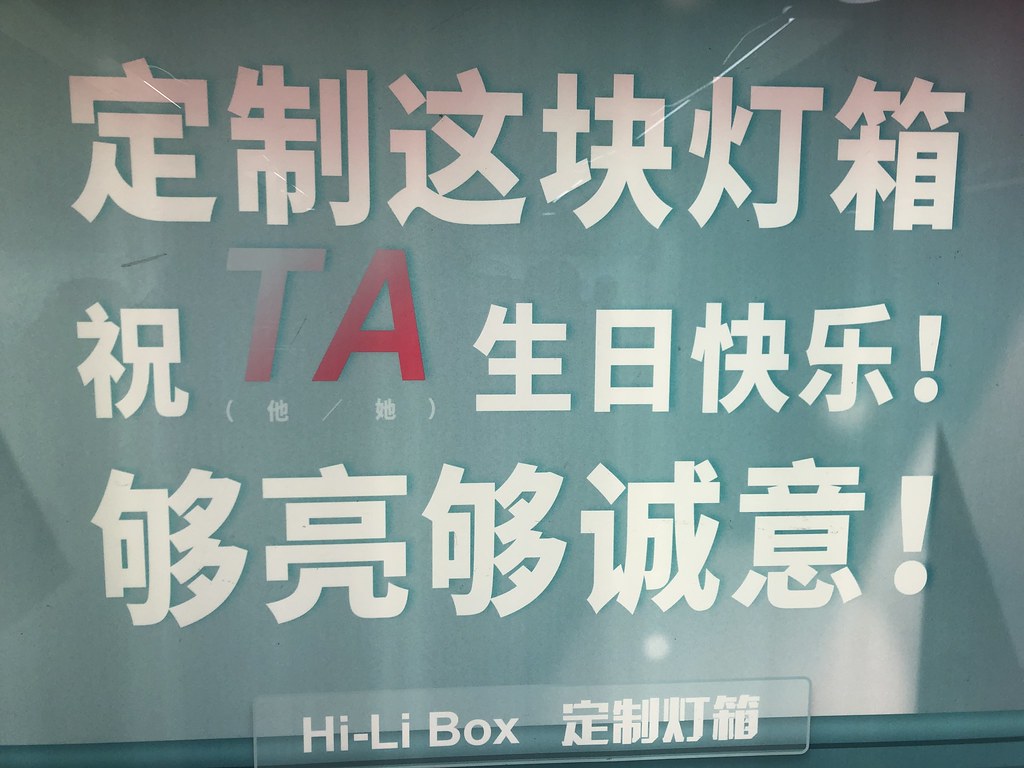
These Shanghai Metro ads are entirely in Chinese except for the “TA.” This phenomenon is fairly common in advertising in China, although these are definitely the best examples I’ve seen because not only are they incredibly clear and highly visible, but they also actually include the meaning of the pinyin “TA” in characters underneath. In case you can’t see clearly, what it says under “TA” is:
( 他 / 她 )
So the point of using “TA” instead of characters is that it leaves the gender unassigned, so that the hypothetical person referred to in the ad can be male or female in the minds of the consumers. I’ve noticed that it is typically written in all caps, as well.
This is, in essence, doing what pinyin does best: providing the sound while leaving the meaning in question. This is something that Chinese characters are often not especially well-suited for, particularly in this case.
(Ironically, the character 他 was not always a “male pronoun” but it kind of evolved that way, and only in the 20th century. Now to escape that corner 他 has been boxed into, the new generation is turning to pinyin.)
For a more scholarly take, be sure to read Victor Mair’s article on Language Log: The degendering of the third person pronoun in Mandarin (Dr. Mair always gets to these topics first!)

05
Dec 2019Free Chinese Christmas Songs to Spice Up the Holidays

It’s Christmastime again, and time to remind everyone that Sinosplice still has some awesome familiar Christmas songs in Chinese. This year I’m posting a selection of the MP3 files online in streamable format, so be sure you’re viewing the original post on Sinosplice.com if you’d like to play the songs without having to download everything.
All right, here we goooo…
Jingle Bells in Chinese
This is version 1 from the album (Mandarin Chinese):
Jingle Bells in Hakka (Hokkien) Dialect
This song is not part of the album because it is NOT Mandarin Chinese. It’s Hakka. (This one is going to have very limited use for most students; it’s just sort of a novelty for most of us.)
Santa Claus is Coming to Town in Chinese
This one is a kids’ version, version 2, also from the album (Mandarin Chinese):
Santa Claus Is Coming to Town (2)
We Wish You a Merry Christmas in Chinese
This song is especially beginner-friendly for learners of Mandarin Chinese (that chorus!):
Silent Night in Chinese
This one is a Christian classic, of course, version 2 from the album (Mandarin Chinese):
Hark! The Herald Angels Sing in Chinese
Another Christian classic, church choir style (Mandarin Chinese):
Download Christmas Songs (zipfile)
If you want to just grab them all, here you go:
The Sinosplice Chinese Christmas Song Album (~40 MB)
+ Lyrics PDFs (1.2 MB)
Disclaimer: I don’t own the rights to these songs, but no one has minded this form of digital distribution (in the name of education) since 2006, so… Merry Christmas?
MP3 Track Listing
- Jingle Bells
- We Wish You a Merry Christmas
- Santa Claus Is Coming to Town
- Silent Night
- The First Noel
- Hark! The Herald Angels Sing
- What Child Is This
- Joy to the World
- It Came Upon a Midnight Clear
- Jingle Bells
- Santa Claus Is Coming to Town
- Silent Night
- Joy to the World
Merry Christmas everybody… 圣诞快乐!
2023 UPDATE:
While we’re on the subject of Christmas and Chinese, AllSet Learning (my company) is doing a special offer with our 1-on-1 online Chinese classes. 3 lessons (one hour each) is a great quantity to try it out or gift to a loved one!

29
Nov 2019A Revamped Newsletter Approach
I’ve never pushed signing up for a newsletter, but since Sinosplice is only updated once or twice a week, I know it can be hard to keep track of posts on here or remember to check. Not everyone likes the “subscribe to blog via email” option because one email for each blog post can be too much.
I’ve had an AllSet Learning newsletter for a while, but since it’s focused mainly on product announcements, it’s been fairly infrequent in the past.
I’ve decided to do something different, though. I’m combining a sort of bi-weekly “Sinosplice blog post digest” with the AllSet Learning product newsletter and adding some other stuff in as well:
- Recent Sinosplice blog posts
- Recent You Can Learn Chinese podcast episodes
- Recent AllSet Learning blog posts and free study materials
- New AllSet Learning product announcements and promo
For anyone who enjoys this blog, it should be a meaty, useful read, released roughly every two weeks.
The signup in the sidebar of the Sinosplice website is for the same newsletter as the signup on the AllSet Learning website.

Sign up and keep the useful Chinese learning-related content coming to your inbox!
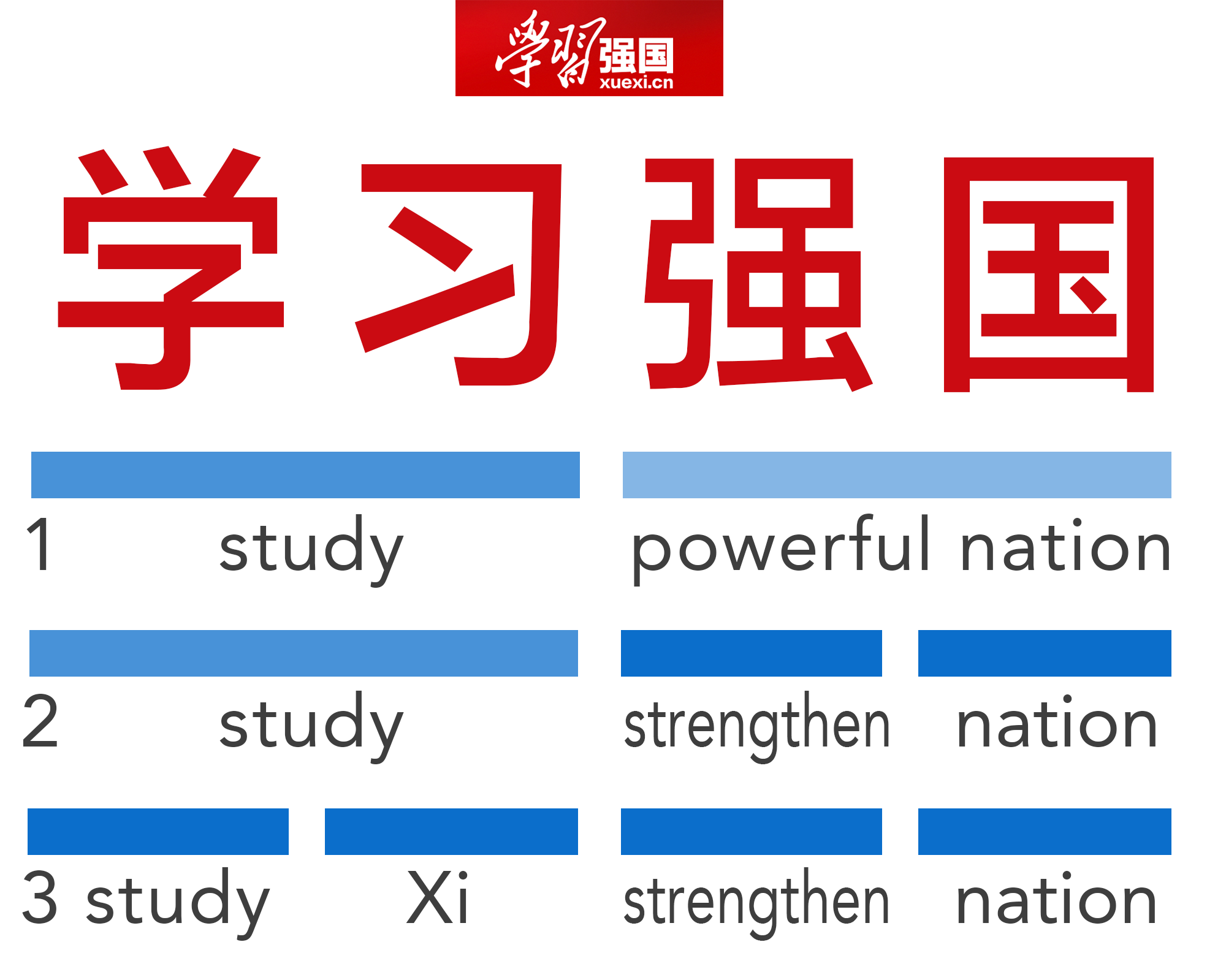
21
Nov 2019Parsing “Xue Xi Qiang Guo” for the Deeper Meaning
A recent topic of conversation among friends in Shanghai is the new app “Xue Xi Qiang Guo.” It’s a news hub for state-sponsored news and commentary, as well as a way to show devotion to the Chinese Communist Party by studying what’s in the app and proving mastery through quizzes. In this way you can get points which can earn you nominal rewards, and it also ties into China’s “social credit” system. (For more info on Xue Xi Qiang Guo, you can check out its official site as well as the Wikipedia’s article.)
What I want to talk about today is the name: 学习强国. If you plug that into Google Translate, Wenlin, or Pleco, you get a similar two-word breakdown: 学习 强国 (xuéxí qiángguó). You’ll note that English news coverage of the app (including Wikipedia) all write the name in pinyin as two words: “Xuexi Qiangguo.”
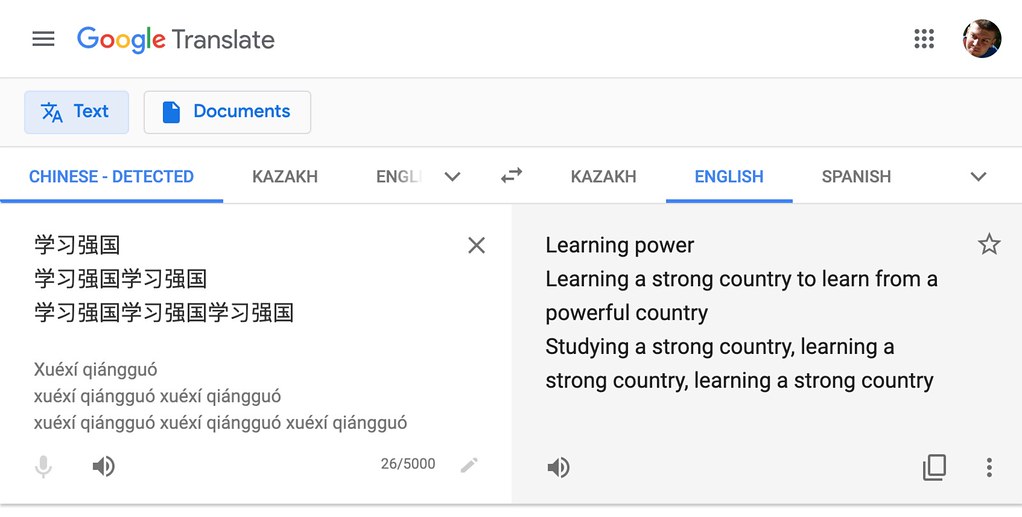
But this is Chinese, where clear word boundaries are not provided, and that is not the only breakdown. It’s not even the one that occurs first to most native speakers of Chinese.
1. Xuexi Qiangguo
OK, so 学习 is a given. it means “study,” and it’s certainly in keeping with the spirit of the app. No problem there. The word 强国, meaning “powerful country,” however, is not so common. The overall interpretation here seems to be “learn from the powerful country (China),” which seems plausible, but it’s just not what occurs to Chinese users first. So let’s drop the 强国 parsing (which, unfortunately, seems to be the norm in English language coverage of the app) and see what else we can get.
2. Xuexi Qiang Guo
Classical Chinese was remarkably flexible, most words consisting of individual characters that can serve as various parts of speech in different contexts (noun, verb, and adjective fluidity being common). This trend carries over to modern times for certain words, and 强 is one of them. So while 强 used by itself is most often used to mean “strong” in modern Mandarin, in certain contexts, 强 can also mean “strength” or “strengthen.” So from there, we can get the two-word phrase 强 国 (qiáng guó), “strengthen the country.”
Since the word 学习 (meaning “study”) can also be a noun or a verb, you might translate the full app name literally as something like “Studying Strengthens the Country,” “Study Strengthens the Country,” or even “Study to Strengthen the Country.” This interpretation would likely be the official meaning of the name if you asked the CCP.
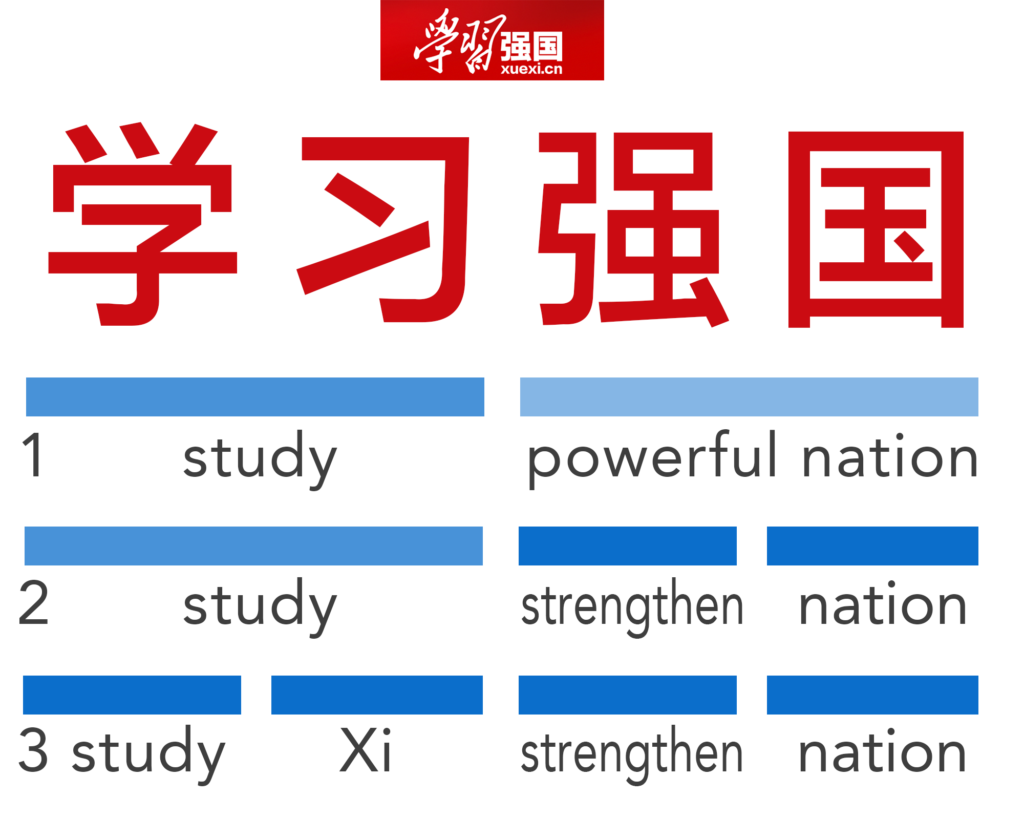
3. Xue Xi Qiang Guo
There’s one other unofficial, sly interpretation which goes unnoticed by few Chinese these days. The word 学习 can also be broken down into two separate words. Since the first character, 学, can mean “study” on its own, and the second character, 习, is also the surname of Xi Jinping (president of China), you can also interpret 学 习 as the phrase “xué Xí,” which means “study Xi” or “learn from Xi.” A quick look at the content of the app shows that this interpretation is, indeed, fully grounded in reality. In fact, some are calling the app the “Little Red Book” of the modern age.
In this parsing, the final meanining of 学 习 强 国 would be “Studying Xi Strengthens the Country.” Since cause-effect relationships are often implied in Mandarin, you could also make that a command: “Study Xi to Strengthen the Country.”
Pretty clever name. It is indeed an age of 学 习 (xué Xí). Now there’s an app for that: Xue Xi Qiang Guo.
Nov. 25, 2019 Update: Dr. Victor Mair shared with me his take on this app, which he wrote on Language Log way back in May of this year. I would have linked to it originally if I had been aware of it: The CCP’s Learning / Learning Xi (Thought) app
19
Nov 2019The Fantastical Creatures of Guan Shan Hai
As a kid, I remember getting my hands on a copy of the Dungeons & Dragons Monster Manual. I loved that book! My very Catholic mother would have denounced it as demonic had she discovered it (it was the 80’s, after all), but I just couldn’t get enough of that art.
Over the years, I’ve also thoroughly enjoyed the imaginative creatures featured in Magic: The Gathering or just random stuff on DeviantArt.
Just recently I came across a book in a book store called 观山海 (Guan Shanhai), just filled with very Chinese illustrations of the beasts from the Chinese classic 山海经 (Shan Hai Jing). I was thoroughly impressed and had to buy it. I’m just sharing a few of the images from the book here.
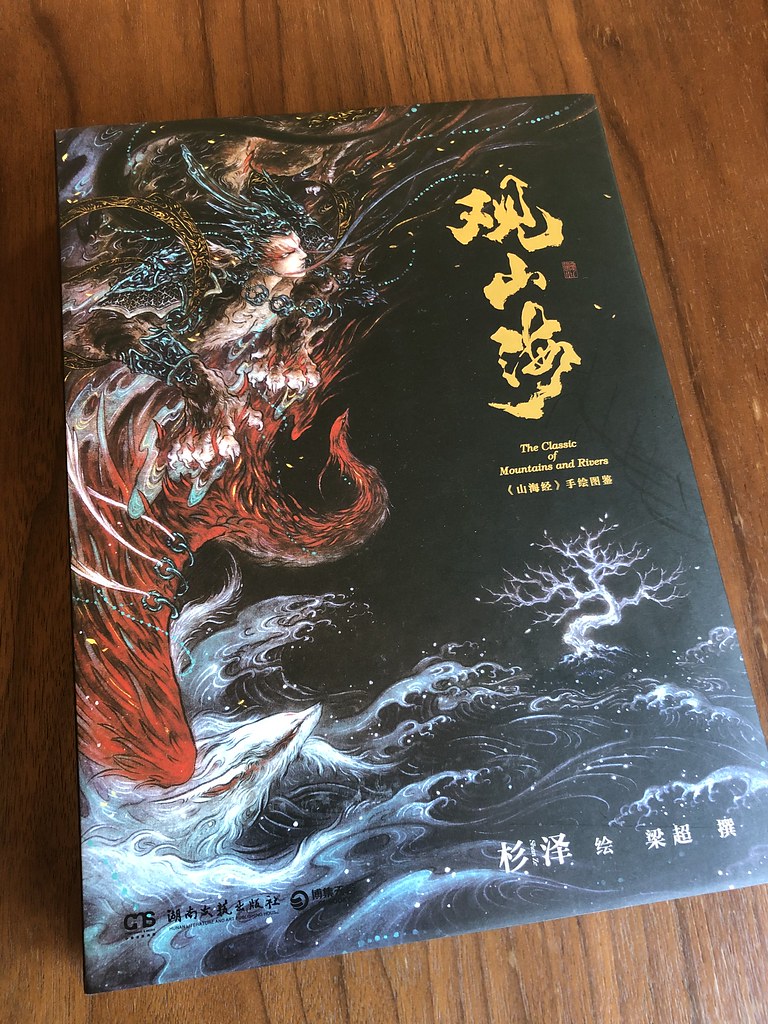

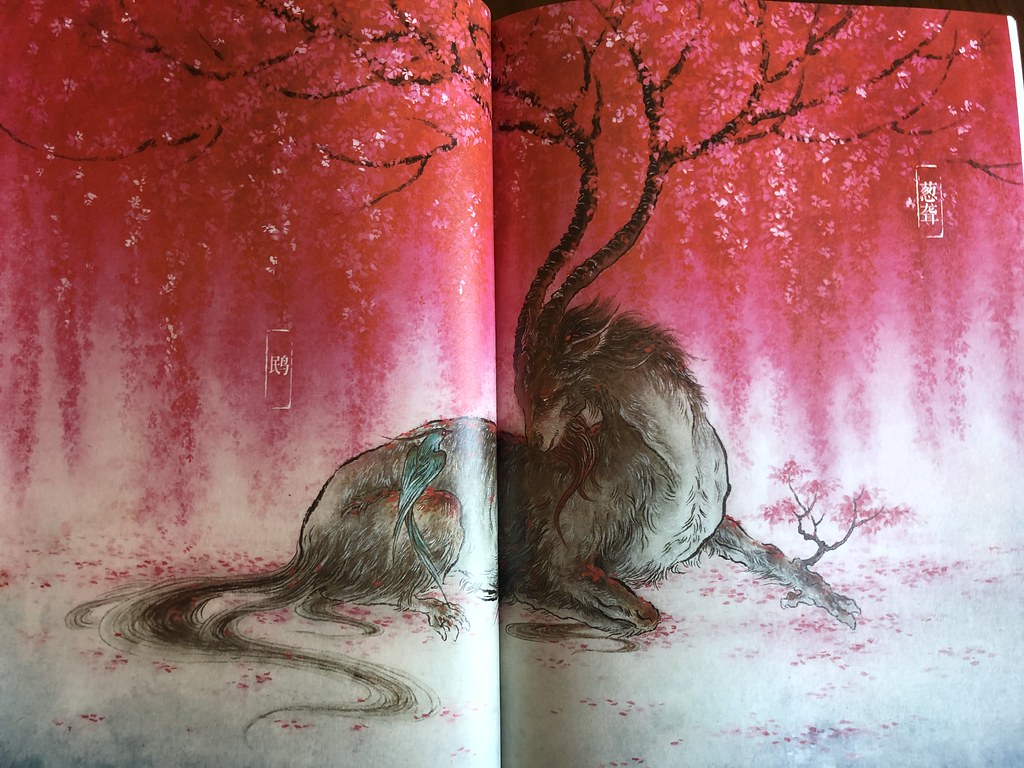


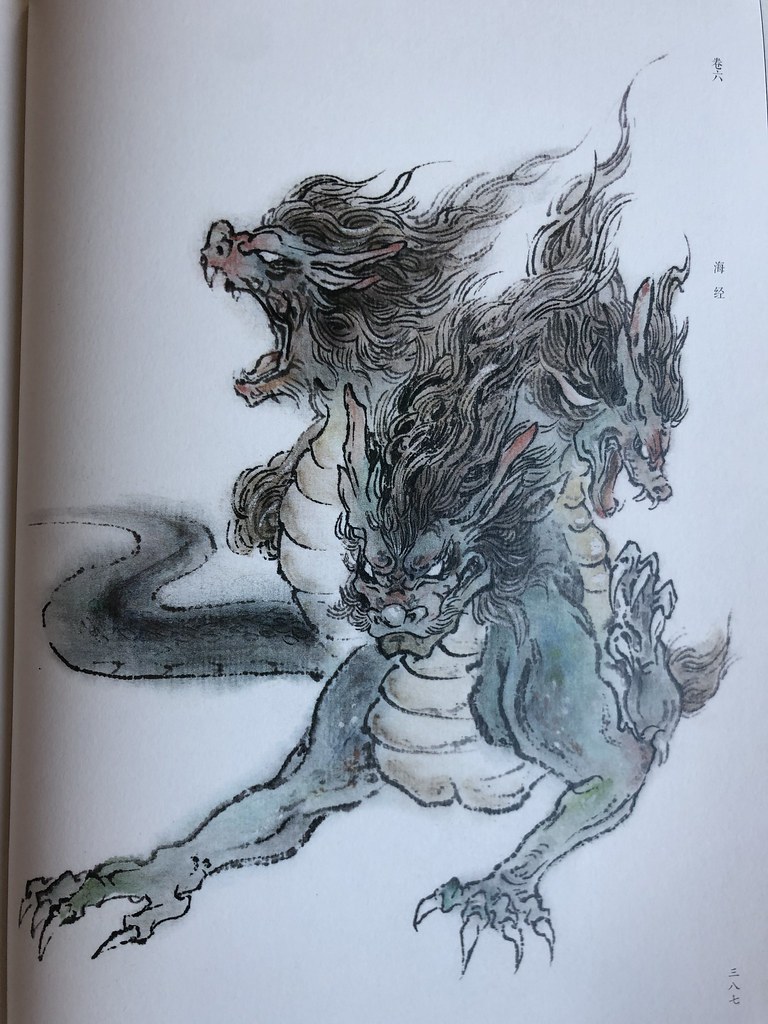
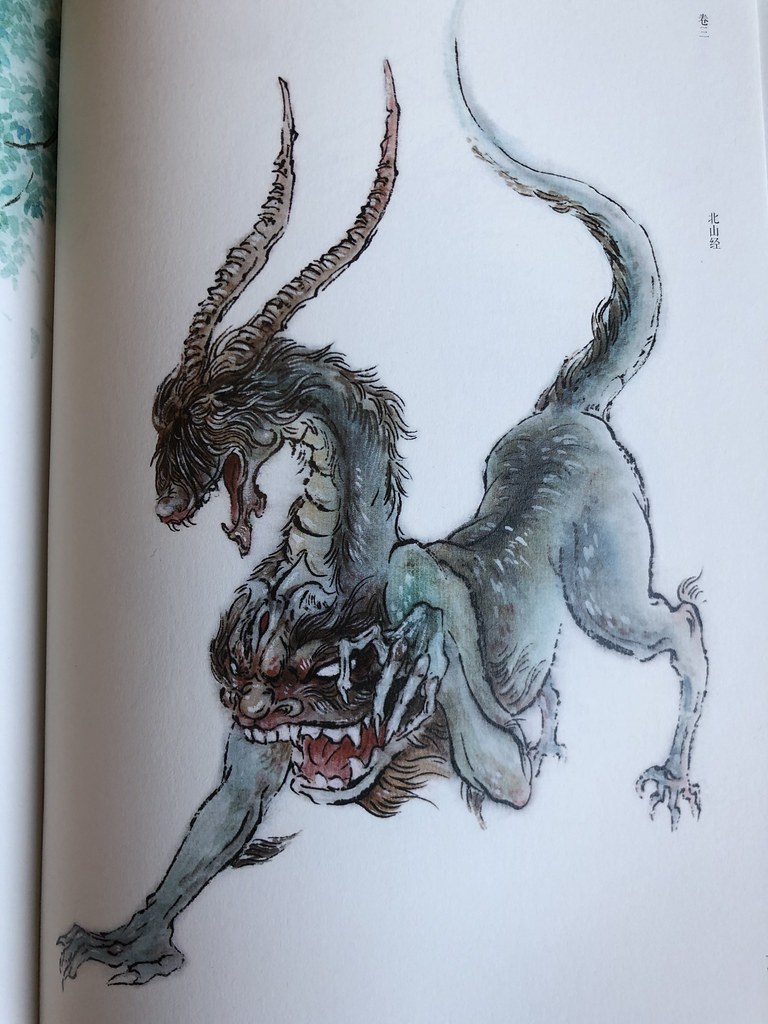

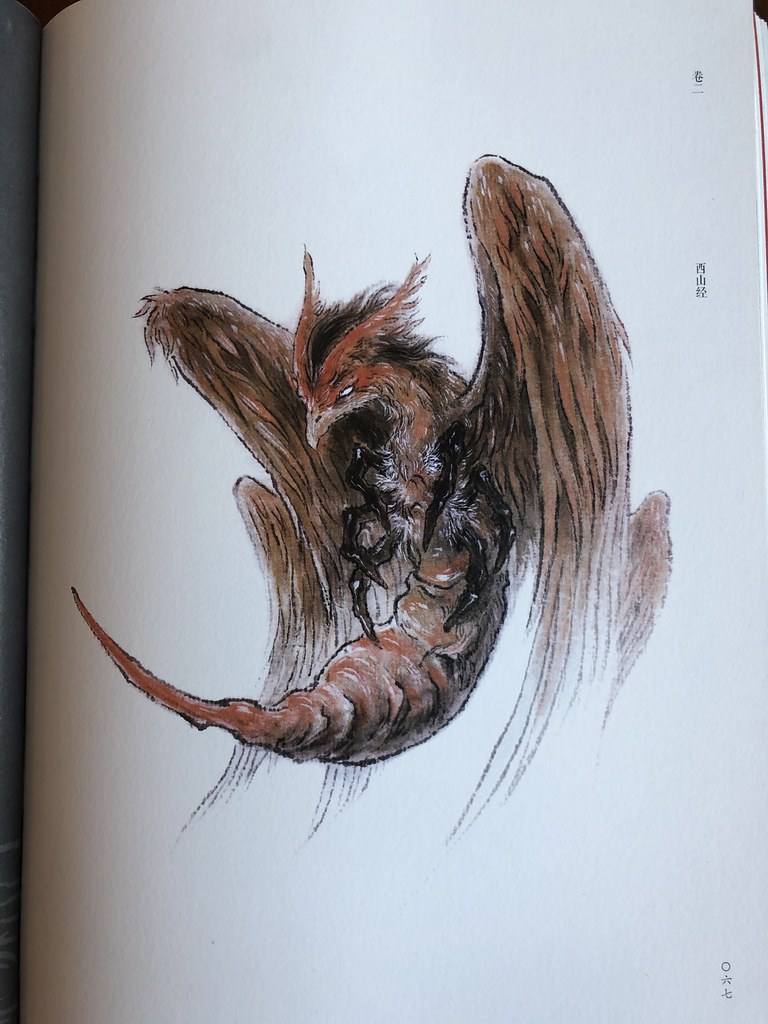


观山海 (Guan Shanhai) is illustrated by 杉泽 (Shan Ze), edited by 梁超 (Liang Chao), and published by Hunan Literature and Art Publishing House, 2018. (Each page has a passage from the Shan Hai Jing as well as commentary, but I skipped all the commentary for this blog post in favor of the gorgeous artwork.)
13
Nov 2019The Bagel Gets No Respect in China
I love bagels. So I have to say: the bagel has gotten a bum deal in China. It starts with the name.

The Chinese Name for “Bagel” is 贝果
Now, of course 贝果 (bèiguǒ) is a simple transliteration for the English word “bagel.” But there are good transliterations, and there are bad ones.
In this case, the character 贝 means “shell” (like in “shellfish”) and appears in words like 扇贝 (scallop) and 贝壳 (clamshell).
The character 果 means “fruit” or “nut” and appears in words like 水果 (fruit), 苹果 (apple), 坚果 (nut), or 开心果 (pistachio nut).
So with regards to the food-related characters used in the Chinese name for 贝果… that’s 0 for 2 on the food groups! Could this name possibly be confusing?
Knowing that bagels are not well-known among Chinese people, I tested my co-workers. I asked them if they’d ever had a 贝果. They said no. I asked them if they knew what it was. They weren’t sure, but guessed it was some kind of nut.
On the upside (sort of?), I’ve noticed that my pinyin input method (Mac) is giving me the option of a bagel emoji as I type 贝果, and it has cream cheese on it! so maybe not all hope is lost for the bagel in China…

And that’s all I have for you today from the world of hard-hitting bagel journalism in Shanghai.
05
Nov 2019The Crosswalk Posts Have Eyes (update)
Just a few days after my last blog post about New Crosswalk Signals, More Surveillance in Shanghai, one of my friends spotted one of the new crosswalk displays doing its thing:

So what are we seeing here? Photos of a guy crossing the street illegally, with a close-up headshot (taken from the same video surveillance). The Chinese text 涉嫌违法 repeats several times, and means “suspected of breaking the law.” Note also that rather than using facial recognition and searching the guy’s face in the database, then showing his official ID photo, what we’re seeing is just a cropped headshot from the video footage. No official IDing of the “suspect.”
This is not to say that none of that is possible; it almost certainly is (and already happening all the time). It’s just that the “citizen-facing” display screens are still in a restrained testing mode. Until all the bugs are worked out, people aren’t going to be receiving automatic tickets for crossing the street illegally at crosswalks across Shanghai… yet.
But obviously, our faces are getting scanned even more often than before now, and with additional scans there’s additional data to improve the facial recognition accuracy.
30
Oct 2019New Crosswalk Signals, More Surveillance in Shanghai
I’ve noticed these new crosswalk signal “posts” going up all around Shanghai. At first glance, they seem to be a user-friendly upgrade, highly visible with all those lights, and clearer. (All the jaywalking was going on before because people couldn’t see the tiny red guy, right? Sure…)
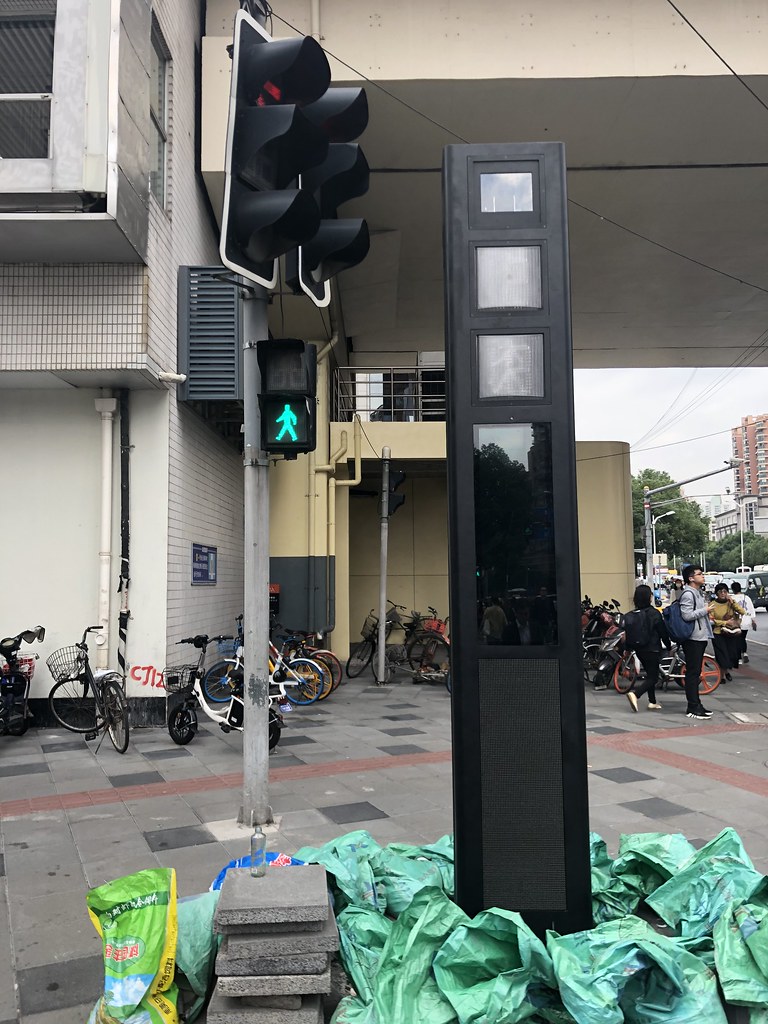
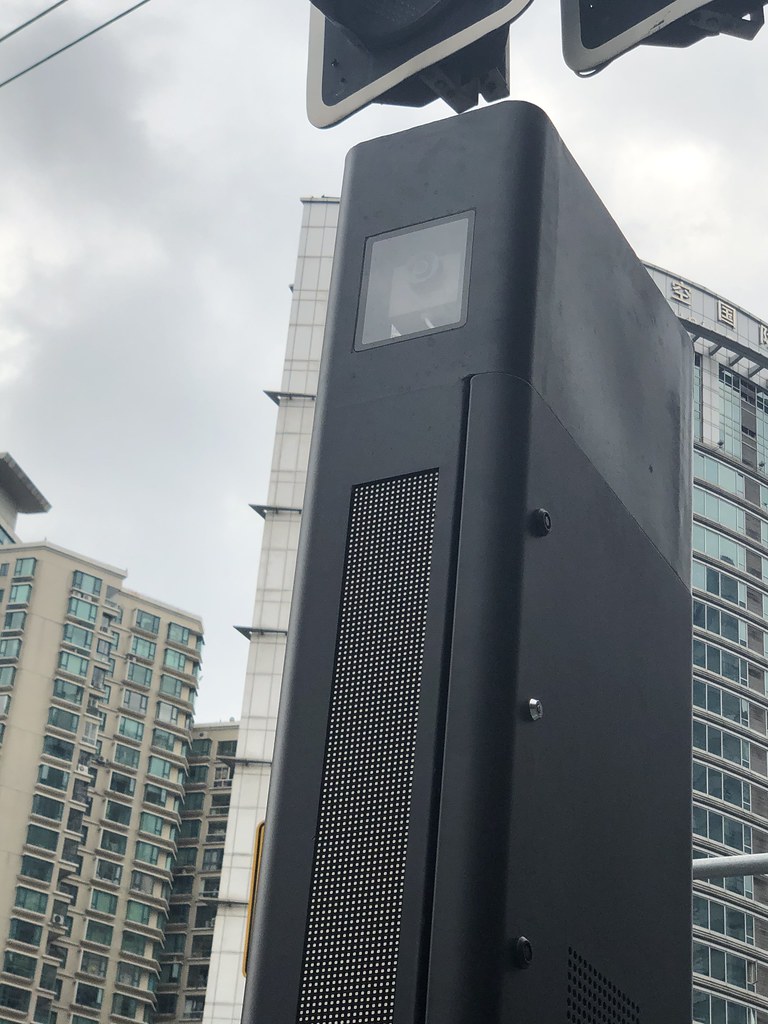

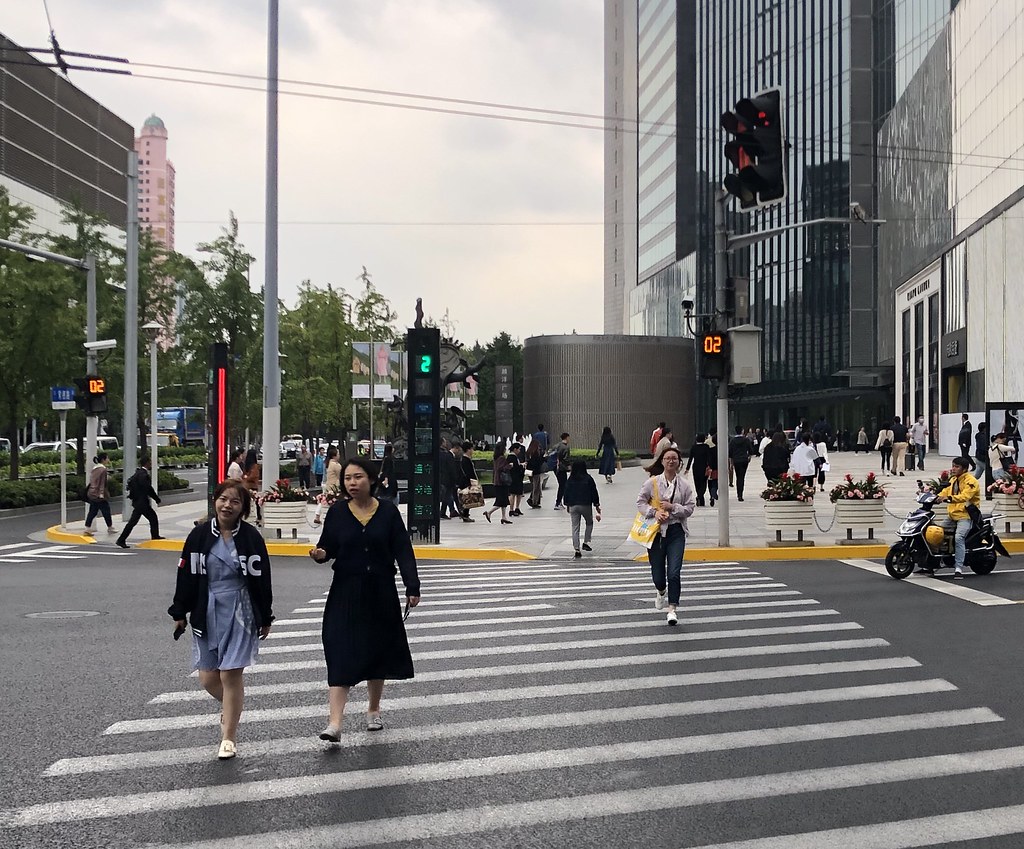

The thing is, when you look closer, you notice to things:
- There’s a space at the top of each post housing three video cameras: one facing the street, and one facing either side.
- There’s a street-facing screen which currently doesn’t have much on it, but kind of looks like a Windows desktop.
Combine these facts with the AI-powered facial recognition craze that’s sweeping Shanghai, as well as the fact that video cameras in Shanghai can already identify and auto-fine automobiles in real time, and it becomes pretty obvious what’s coming: these crosswalk posts are going to start identifying any jaywalking citizens and fining them automatically. (The little blue and white notice in the bottom photo also says as much.)
As for the under-utilized screen? Possibly it will be used to display photos of offending jaywalkers. (When you get auto-fined on Shanghai’s elevated highways, an LED text screen immediately displays your license plate number, notifying you that you’ve been fined.)
Of course, these crosswalk signal posts won’t do much to stop people from traipsing across streets at other locations, and what happens when people start wearing masks, or wrapping their jackets around their heads specifically to confound the technology at these intersections? Unclear.
It’s a brave new world for Shanghai crosswalks…
Nov. 5, 2018 Update: The Crosswalk Posts Have Eyes
23
Oct 2019One Key Cultural Difference, Demonstrated
You often hear about “the importance of culture” when you learn a language (and I recently did a podcast on that very topic), and a lot of attention is given to “cultural differences” as well. And yet, it’s the kind of thing that doesn’t seem very real until you’re deep into it yourself. It’s kind of hard to demonstrate simply, in an impressive way.
Well, no more! This image will do the trick:

Recently I’ve shown this image to quite a few Chinese friends and co-workers, asking them, “what do you notice right away about this image? What do you think it means?“
With very few exceptions, the Chinese people will talk about the cell phone, and then the gun. The skin color of the person is usually entirely overlooked. Obviously, Americans tend to have a very different answer to those questions.
Then, when you explain how most Americans will view the image, expect a very interesting conversation to follow! Try it.
16
Oct 2019AllSet Learning Has a New Look
I’m pleased to announce that AllSet Learning‘s main website has had a significant makeover. The previous website was built in 2010, and while it worked well enough, these days it was looking more and more like it was built in 2010. No longer!

We’re still doing the VIP hyper-personalized services that we’ve always done (both offline in Shanghai and online), but we also offer some very cool “themed courses” now. They’re real-time online 1-on-1 lessons, focused on a particular topic, but designed to encourage lots of discussion and speaking practice.
Thanks for taking a look at the new site!
11
Oct 2019Weighing Elephants and Difficulty
I recently posted a bit about my daughter’s Chinese first grade Chinese language (语文) textbook. I haven’t found the time to dig deeper yet, but I couldn’t help but notice this story from her second grade textbook (and sorry, these photos are not pretty…):
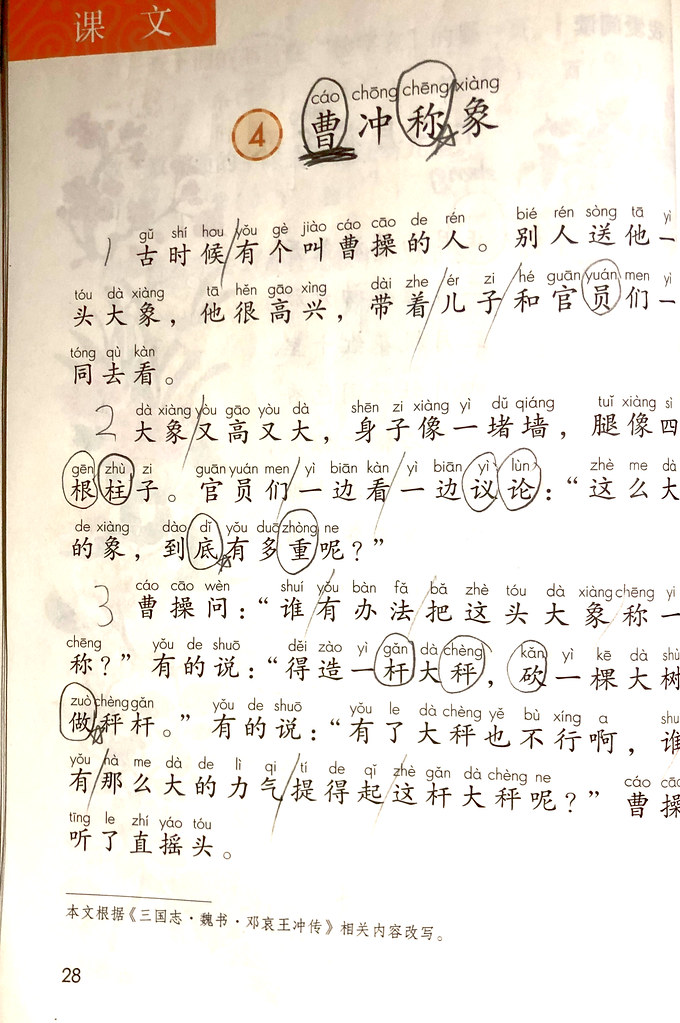
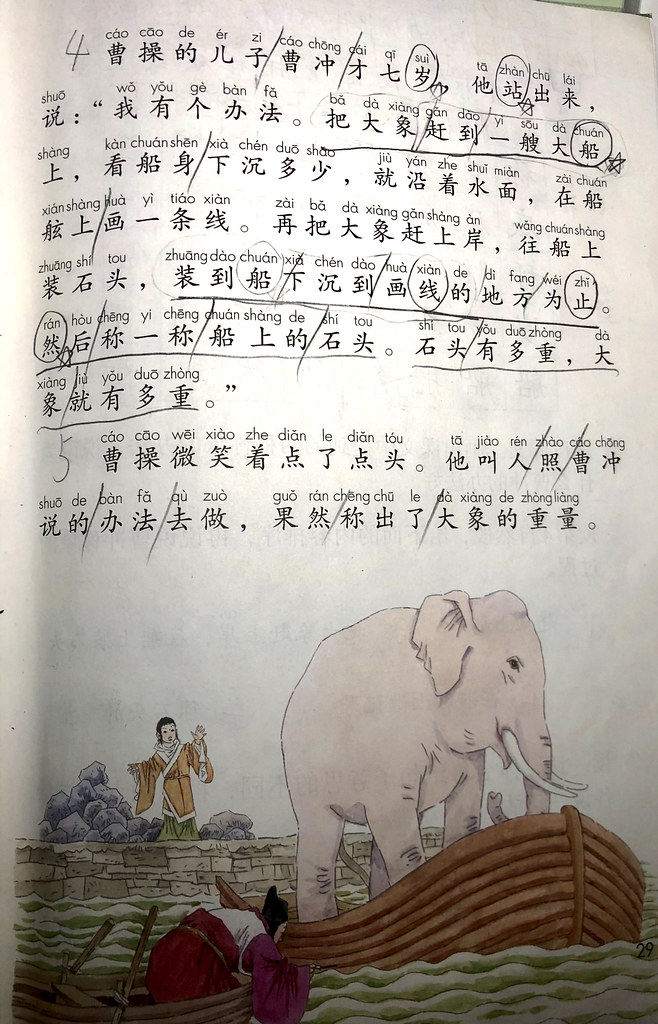
The story of 曹冲 (Cao Chong) devising a way to weigh an elephant is a classic story in China. I wasn’t aware until now that (apparently) second grade is the time for a Chinese child to learn it, if she hasn’t already.
What struck me as interesting about this story is that the very same story is the subject of an Upper Intermediate ChinesePod lesson from 2011: How to Weigh an Elephant (hosted by Jenny Zhu and me). Much of the vocabulary is the same, and the difficulty level is roughly equal.
So… in this particular case, a second grade reading for Chinese kids matches up with an upper intermediate lesson for foreign learners. I’m still exploring the ways that first and second language acquisition differ, in terms of relevant topics, vocabulary, grammar, etc., but this one really jumped out at me.
30
Sep 2019New MacBook, Chinese-r Keyboard This Time
One of the reasons I haven’t been posting lately is that I’ve been struggling with the recovery of a broken MacBook Pro. It was of the (2016) first generation Touchpad line, and, quite frankly, it hasn’t been a great machine. I haven’t lost all faith in Apple hardware yet, but I’ve lost faith in this particular model. I’ve switched back to a MacBook Air. (My old MacBook Air from 2011 still runs like a champ after just a battery replacement a while back, but it’s hard drive is a bit small for today’s standards.)
Anyway, this time it made the most sense to buy the computer in China. You pay significantly more (roughly 1000 RMB) when you buy a MacBook in China as opposed to the US or Japan. What do you get for the extra money?
Well, not much, but you do get a keyboard that looks like this!
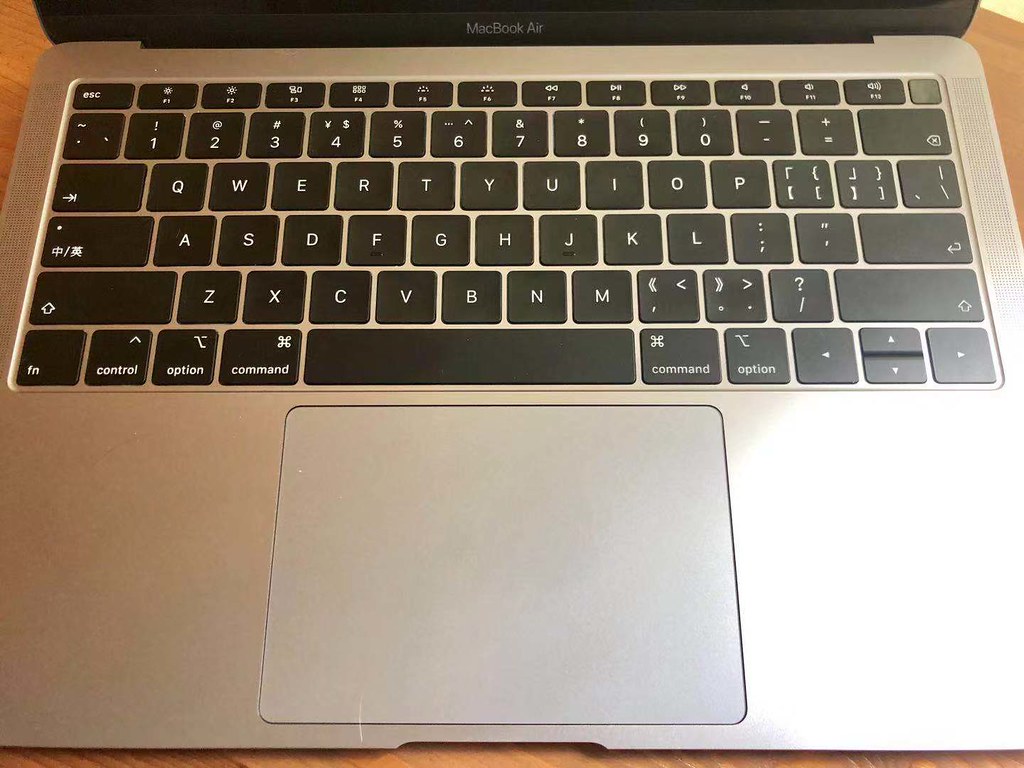
It’s actually quite nice to have those Chinese punctuation marks on the keys. (There are a few that I don’t use often and always forget where they are, frequently resulting in a ridiculous trial-and-error key-pecking hunt.) Also, this computer natively repurposes Caps Lock as the “language toggle key” (labeled “中/英”). This is awesome! I didn’t realize how much I was missing.
(Worth 1000 RMB? OK, yeah, that’s a stretch…)
Only problem now is that when I add in a third language (Japanese), the toggle doesn’t work for that one. Anyone out there know the particulars of this specific customization? I need to look into it some more…
